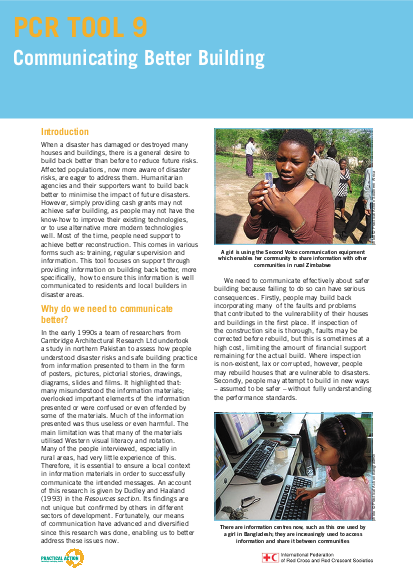
In the early 1990s a team of researchers from Cambridge Architectural Research Ltd undertook a study in northern Pakistan to assess how people understood disaster risks and safe building practice from information presented to them in the form of posters, pictures, pictorial stories, drawings, diagrams, slides and films. It highlighted that: many misunderstood the information materials; overlooked important elements of the information presented or were confused or even offended by some of the materials. Much of the information presented was thus useless or even harmful. The main limitation was that many of the materials utilised Western visual literacy and notation. Many of the people interviewed, especially in rural areas, had very little experience of this.
Therefore, it is essential to ensure a local context in information materials in order to successfully communicate the intended messages. An account of this research is given by Dudley and Haaland (1993) in the Resources section. Its findings are not unique but confirmed by others in different sectors of development. Fortunately, our means of communication have advanced and diversified since this research was done, enablin us to better address these issues now.
We need to communicate effectively about safer building because failing to do so can have serious consequences. Firstly, people may build back incorporating many of the faults and problems that contributed to the vulnerability of their houses and buildings in the first place. If inspection of the construction site is thorough, faults may be corrected before rebuild, but this is sometimes at a high cost, limiting the amount of financial support remaining for the actual build. Where inspection is non-existent, lax or corrupted, however, people may rebuild houses that are vulnerable to disasters. Secondly, people may attempt to build in new ways – assumed to be safer – without fully understanding the performance standards.
Resource collections
- Accountability to affected populations (AAP)
- Evaluating humanitarian action
- Topics
- UN Habitat - Urban Response Collection
- Urban Response - Urban Crisis Preparedness and Risk Reduction
- Urban Response Collection - Community Engagement and Social Cohesion
- Urban Response Collection - Economic Recovery
- Urban Response Collection - Environment and Climate Change
- Urban Response Collection - Housing, Land and Property
- Urban Response Collection - Urban Crisis Response, Recovery and Reconstruction
- Urban Response Collection - Urban Resilience
